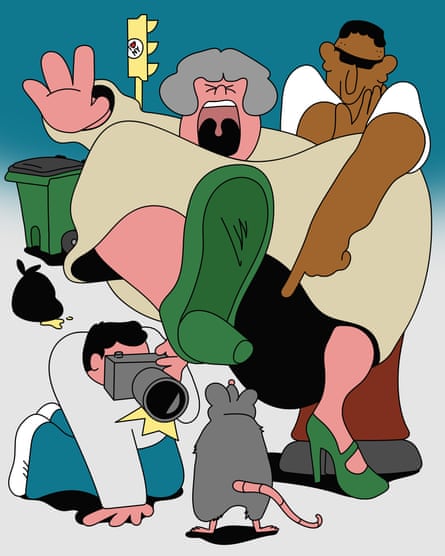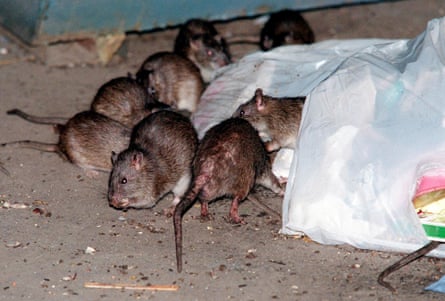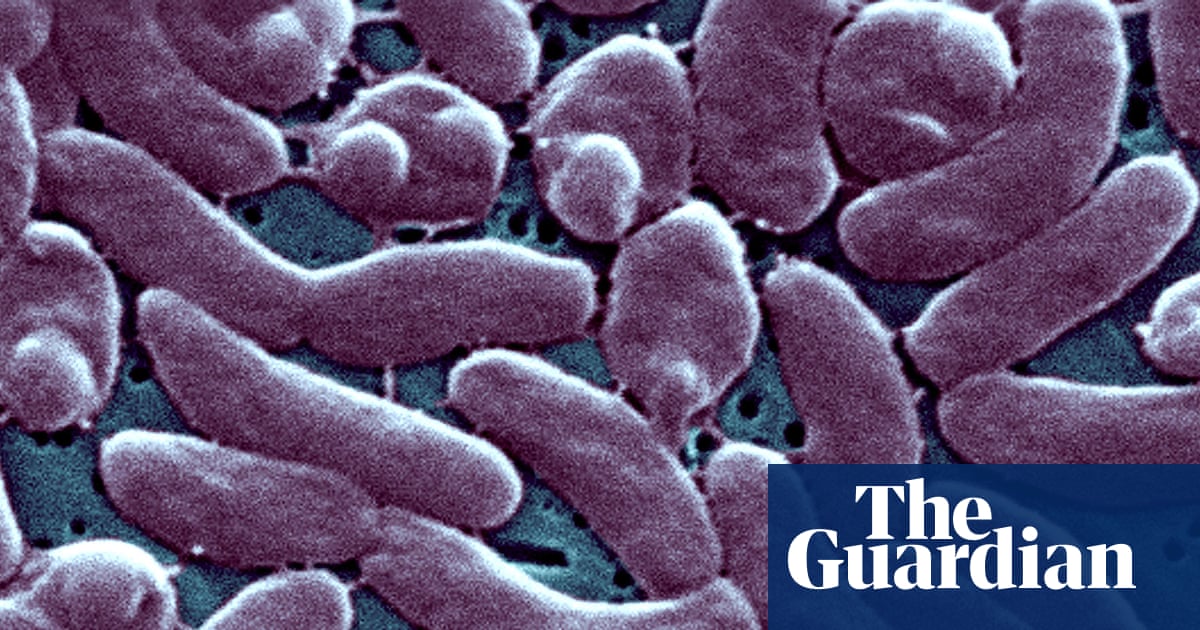
I am standing near a tree bed in a bustling Brooklyn park, with only a few feet of dirt separating me from a “small” family of rats – that’s usually around 8 of them, I’m told. I’ve come on this “rat walk” with a few dozen New Yorkers, all milling about awkwardly, subjecting ourselves to the kind of brainless small talk heard at speed dating events. But instead of looking for love, we’ve come to learn more about New York’s rodent population. Tonight, knowing thy enemy means we must slink among the rats.
We’re led by Kathleen Corradi, the city’s famed rat tsar, appointed by Mayor Eric Adams in 2023, and we are united by our visceral hatred of rats. We don’t want to see them scurry by on late-night walks home, or watch as they slink in and out of trash bags on the street. We especially don’t want them in our homes. As one exterminator put it to famed metro reporter Joseph Mitchell back in 1944: “If you get a few [rats] in your house, there are just two things you can do: you can wait for them to die, or you can burn your house down and start all over again.”
An estimated 3 million rats live in New York – far less than the fabled “five rats for every person” urban legend, but enough to cause problems. While it’s unlikely you’ll catch the plague, rats can spread leptospirosis, with a record 24 New Yorkers coming down the disease in 2023. Rats contaminate food, damage property and make a notoriously difficult city even harder to live in by ick factor alone.

But game must recognize game. New Yorkers are nothing if not tenaciously, blindly in love with our city. Rats, despite humans’ determined efforts, refuse to leave it. A lowly transplant might wear a “New York or Nowhere” T-shirt today but move back to Ohio in a few years. Rodents have their claws sunk into New York, enmeshed in its lore. You have to give them that much.
This begrudging acceptance – what Corradi calls “the fear and fascination” – powers New York’s Rat Pack, a club of “anti-rat activists” who attend three events including a rat walk for education on easing human-rat relations. And for free swag: people who complete the training receive a T-shirt or hat with the Rat Pack logo. (For a club that aims to defeat rats, they sure made their enemy look cool as hell.)
When I did my rat walk, I learned that I live in one of New York’s official Rat Mitigation Zones (shortened to the rather militaristic-sounding RMZ). To be fair, I didn’t need Corradi to tell me this. Rats are everywhere. They live in the walls between apartments. They chew through the electrical wiring on cars. At night, I often find myself stepping off the sidewalk to let them pass by first.
In 2022 Jessica Tisch, then the sanitation commissioner, announced their status as public enemy. “The rats don’t run this city, we do,” she insisted during a press conference about a new garbage policy requiring landlords use bins with lids. It had taken New York, which was founded in 1624, 400 years to come to the realization that “putting lids on trash cans” deters rodents – an undeniable victory for the rats. Soon enough, residents received fliers depicting a cast-out rodent toting a suitcase telling us to “Send rats packing!” Some wondered: did they have to make the forlorn rat look so cute?
In 2023, Corradi got a $3.5m budget to raise public awareness about rat mitigation. The city had long given up on any hope of totally eradicating them, and now prioritizes damage control. It has tried gassing rats by pumping their burrows with carbon monoxide. One vigilante group hunted them down with dogs. Last year, the city passed a law initiating rat birth control in the form of non-toxic pellets, winning the support of the notoriously hard-to-please animal rights group Peta, because it replaces rat poison.
My rat walk took place on a chilly evening in April. As Corradi led us around the park, I learned rats only need one ounce of food a day to survive – a minuscule amount compared to the amount of trash on the streets. She urged us to remind our dog-owning friends that rats can survive off the undigested food in pup poop left on the sidewalks (a fun fact to bring up at dinner parties). She encouraged us to report bad actors such as landlords who flout codes intended to mitigate rodents.
Corradi also pointed out telltale signs: you can see rats even when they’re not scampering around, from the holes they dig for shelter, to the discarded soda cans or potato chip bags they essentially recycle to cover their burrows, to the droppings they leave.
The lesson: don’t get too comfortable.

Ultimately, Corradi said, we’re not so different from rats. Like us, they’re looking for a home in a crowded, often inhospitable city.
Studies have shown people who live near infested areas report greater psychological trauma, trouble sleeping and overall stress. All New Yorkers deal with rats, but the RMZs are historically lower income areas, such as the Bronx’s Grand Concourse, Harlem, Chinatown, the East Village and Bed Stuy and Bushwick. In 2016, researchers from Johns Hopkins found that people who live in low-income areas consider rat infestations as distressing as drug sales on the street and the threat of random violence. Recent spikes in rat sightings have also been tied to rapidly warming cities.
The rat tsar noted, with a bit of frustration, that the city’s leaders cannot curb this issue on their own; they rely on us to do our part. During this rousing kicker, a young man pointed toward the sky. We all looked up to see a hawk perched on a lamppost with something dangling from its mouth. Was it a rat? It sure looked like one. With that, we were dismissed from our walk, the hawk as our new rat prevention role model.
A few weeks later, I pulled up to a community center for a “Rat Academy” session – part two of the Rat Pack curriculum. Ostensibly, it was a lecture, but the audience was mostly home or business owners there to complain about the rat problem. Some detailed specific-to-them anecdotes about careless neighbors or insufficient action following reports of rat activity to 311.
Again, it was stressed that it takes a village. Know your neighbors, so you can speak honestly with the guy who isn’t putting his trash out correctly, or the woman down the street who doesn’t pick up after her dog. Rats, who live communally, band together for survival. They look out for each other. Humans haven’t really nailed this yet.
When we got to the topic of rat birth control, one woman raised her hand and asked, with a straight face, “Does it work on humans? Because birth control… that’s a hard thing to get these days.” (It does not.)
What would New York be without rats? It’s a futile question: most experts believe that the war on rats is fundamentally un-winnable. We’ve been trying to kill these guys since the Middle Ages. To quote a 2022 study, “there is no overarching solution” to the rat problem. We have to layer on all of our efforts – high-tech trash cans (OK, just ones with lids), birth control, cleaning up dog poop – to manage the population, and even then we’ll still have rats.


So was the whole “the rats don’t run this city” thing wishful thinking? Not exactly. Scientists say we’re entering “a new golden age” of rat research that could push mitigation efforts into overdrive. As Kaylee Byers, assistant professor at Canada’s Simon Fraser University, told NPR this year: “We need to not only understand the rat, but we actually also have to understand ourselves and our relationship to rats in order to move towards a healthier coexistence.”
My final task, which would earn me a spot in the Rat Pack: volunteer service. For three hours on a Friday morning in Queens, I picked up trash and rehabbed trees, putting down new soil around their trunks. Fellow volunteer Alex, a freshly retired employment lawyer and Grateful Dead fan, told me he was a vegetarian and big animal lover. But when I asked him how he felt about rats, he shuddered. “Absolutely not,” he said. “I hate them all.”
I had good news for Alex. According to new city data, rat sightings are down 18.4% this year in all boroughs, but especially my home in Brooklyn, which saw a 28.6% reduction.
Still, any reports of the death of New York’s rat population would be premature. The rats who live on my block – and maybe yours, too – seem quite comfortable indeed.

 2 months ago
109
2 months ago
109

















































